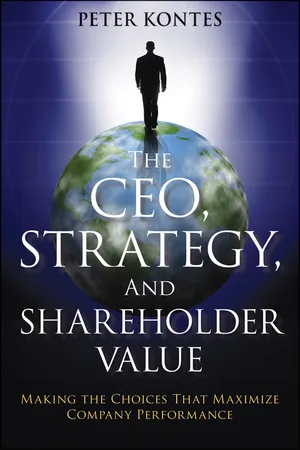Financial Objectives
Financial objectives refer to the specific goals a business sets to manage its finances effectively and achieve desired outcomes. These objectives typically include targets for revenue, profitability, cash flow, and financial stability. By establishing clear financial objectives, a business can align its resources and efforts to maximize financial performance and support overall strategic goals.
7 Key excerpts on "Financial Objectives"
- eBook - ePub
Enterprise Risk Management
A Methodology for Achieving Strategic Objectives
- Gregory Monahan(Author)
- 2008(Publication Date)
- Wiley(Publisher)
...I have grouped the objectives that share common or like metrics. Having said that, once you understand the methodology, you may well derive a classification that differs to the one proposed here and makes more sense to your organization. Financial Objectives Of all of the risks facing an organization, those that impact bottom-line numbers are, for pretty obvious reasons, the most popular ones. By "popular” I mean they receive the most attention. There are a number of reasons for this, including the fact that data is usually publicly available (often by law), the subject is what drives the vast majority of organizations and their investors, and, to date, this data has been the easiest to obtain and understand. Although there are probably hundreds, possibly thousands, of variations, Financial Objectives typically boil down to two categories: strength of the balance sheet and financial performance. Statement of Financial Position The statement of financial position (formerly known as the balance sheet) records the organization’s financial position at any point in time. It categorizes the organization’s objects into things the organization owns (assets) and things the organization owes (liabilities and owners’ equity). Some typical Financial Objectives that relate to the statement of financial position are listed in Exhibit 2.1. EXHIBIT 2.1 STRATEGIC OBJECTIVE METRICS RELATING TO THE STATEMENT OF FINANCIAL POSITION Statement of Financial Performance The statement of financial performance (formerly known as the profit and loss statement) shows how well the organization performed, at least with respect to those things measured by accountants over a certain period...
- eBook - ePub
Business
The Ultimate Resource
- Bloomsbury Publishing(Author)
- 2011(Publication Date)
...Setting Objectives for a Business by Allan A. Kennedy EXECUTIVE SUMMARY • Managing inherently involves setting a goal or objective and then executing a series of actions to meet it. Establishing the right objective is critical to successful management of any business. • Successful long-term businesses almost always started with a set of nonFinancial Objectives (sometimes referred to as a vision or mission) and derived Financial Objectives consistent with pursuit of their broader goals. • Setting only Financial Objectives is risky for a business because single-minded pursuit of Financial Objectives can lead to actions that undermine long-term viability. INTRODUCTION Managing is the task of moving an enterprise toward a defined objective. Most of the disciplines of management—budgeting, strategic planning, performance monitoring—take as a given that an appropriate objective has been set. Given the central role that objectives or targets play in most management actions, it is critical that they be set correctly. It may seem trite to point out, but it is none the less valid: if inappropriate objectives are set for a business, inappropriate outcomes will occur. What constitutes appropriate objectives for a business? As business and management have evolved, thinking about what constitutes an appropriate objective has evolved as well. Throughout this evolution, there has been an ongoing tension between financial goals and objectives and nonFinancial Objectives. If business exists primarily or solely to make a profit (a highly quantifiable outcome) then relatively simple Financial Objectives suffice, argue some. Others say that business exists to serve simultaneously the needs of various constituencies—stockholders, customers, suppliers, employees, communities. The interests of these various legitimate constituencies are not always quantifiable, leading to a school of thought that puts greater emphasis on nonFinancial Objectives...
- eBook - ePub
Armstrong's Handbook of Performance Management
An Evidence-Based Guide to Performance Leadership
- Michael Armstrong(Author)
- 2022(Publication Date)
- Kogan Page(Publisher)
...11 Defining objectives Introduction Objectives indicate what has to be accomplished. Their definition is a fundamental activity in managing performance. They provide direction and a basis for monitoring performance, and they help to communicate the organization’s strategic goals to employees. This chapter starts with a definition of the meaning of the term ‘objectives’ and continues with a review of the conceptual background and a description of the processes of defining objectives and strategic alignment. The meaning of objectives The terms ‘objectives’ and ‘goals’ are often used interchangeably, both meaning an outcome to be achieved. But it is possible to distinguish between them. Goals are expressions of overall ambitions and intentions. They set out what, in general, an organization or an individual wants or needs to do in the longer term. Objectives are specific aims or targets, the achievement of which will support the attainment of these goals. Thus the strategic goals for a business could be to increase market share, to improve productivity and to minimize harmful impact on the environment. In each of those areas objectives could be set in the form of quantified targets or a definition of some other form of measurable achievement. Individuals have overall goals, for example, to improve performance, behave in accordance with accepted standards, develop skills or further their careers. They also have objectives in the form of the precise actions and measurable steps required to achieve overarching goals – those of the organization (the process of strategic alignment) as well as their own. There are two types of objectives: performance and personal. Performance objectives Performance objectives are generally expressed by simply defining each of the main activities the role involves in terms that indicate the expected outcomes or the purpose of the activity...
- eBook - ePub
- Jim Blythe(Author)
- 2012(Publication Date)
- Routledge(Publisher)
...In the case of a truly marketing-orientated firm, corporate objectives and marketing objectives should be almost identical: but most firms are not as marketing orientated as this, by any means. Corporate objectives are strategic statements of where the organisation’s senior management thinks the organisation should be. Objectives can be grouped as follows: Financial Objectives. These relate to sales, profits, return on investment, balance sheet issues and so forth. Philosophical objectives. These might encompass such factors as the core values of the organisation, a desire to be the biggest or the best or the most caring or (of course) customer orientation. Qualitative objectives. These are to do with service levels, the desire to be innovative or perhaps the desire to be respected as a good employer. There will often be trade-offs in corporate objectives, since all organisations have limited resources and therefore cannot do everything they might want. The following is a list of possible conflicts in setting objectives (Weinberg, 1969): 1. Short-term profit versus long-term growth. Going for a quick profit is likely to sabotage longer-term steady growth, because the firm will launch products too soon, over-pressure customers to place orders now rather than later and cut back on long-term investments in research and brand building. 2. Profit margin versus market positioning. Investment in brand building and positioning the brand is likely to cost money, which of course affects the profit margin: likewise, some positions (e.g. a low-price position) will involve reducing margins so as to offer low prices. 3. Direct sales effort versus market development. Making quick sales may well involve tactics such as strong sales promotions which will affect people’s perception of the brand in the longer term. 4. Penetrating existing markets versus developing new ones. Gaining greater sales from existing markets will take resources away from moving into new markets and vice versa...
- eBook - ePub
- Alan J. Baker(Author)
- 2018(Publication Date)
- Routledge(Publisher)
...In contrast to managerial theories, the objective prescribed by the great majority of business finance theorists, and apparently accepted as a guiding principle by firms (see Mao, 1970), is the maximisation of the market value of the owners’ wealth (generally, the ex dividend stock exchange value of equity capital plus whatever dividend is to be paid in the near future). The breadth of theoretical support for this interpretation of the firm’s objective must be due to its almost unarguable appropriateness, as well as to its overriding simplicity. What could be more fitting than that managers should direct their efforts to making shareholders as wealthy as possible, within the prevailing moral code and the existing legal framework? An added attraction, at least to economists, is the suggestion that in maximising the wealth of investors, managers are also tending to promote the general good of society (e.g. Solomon, 1963, pp. 23-4). The inevitability of a multi-period interpretation of the firm’s financial objective is obvious. Profit maximisation as a view of the firm’s objective suffers from three kinds of difficulty: profits accrue at different points in time; profit prospects in later years may be affected by the firm’s price and output policies in earlier years; and profit is generally subject to risk. These factors all suggest the need for a valuation model to enable a decision maker, whatever his motivation, to compare policy options with uncertain consequences extending beyond the current period. 1.4 (ii) The Instruments of Financial Policy No prescriptive criterion, however obvious as a general principle, can hope to carry conviction unless it can be made operational. Nor can we hope to bypass the issue of the firm’s short-period objective and behaviour simply by shifting our focus to the level of the firm’s overall objective...
- eBook - ePub
- Barry Witcher(Author)
- 2019(Publication Date)
- Routledge(Publisher)
...5 Objectives Essential summary Objectives are strategically desired outcomes that must be managed effectively if the organization is to continue to fulfil its purpose. The balanced scorecard is a documented set of objectives and measures grouped typically into four perspectives. Critical success factors (CSFs) are the factors that primarily account for an organization’s success in achieving its strategic purpose. Key performance indicators (KPIs) are targets used to monitor progress on strategy-related incremental objectives. Strategy maps are pictorial representations of the relative order of balanced scorecard perspectives, which are used to illustrate cause and effect. Strengths, weaknesses, opportunities, threats (SWOT) is a mnemonic framework used to strategically analyze an organization’s strengths, weaknesses (concerned with internal factors), opportunities, and threats (arising because of changes in external factors). An objective is a statement of a specific outcome that is to be achieved. Objectives must be meaningful and clear to the people who use them and linked to realistic measures of progress so that those managing the objectives will know in enough time if it necessary to intervene and make appropriate changes. Objectives are the basis of a common language for understanding the context of work and identifying the inevitable knock-on effects of change. Of course, this requires common ways of working that are based on dialogue and consensus to facilitate the development and management of objectives in ways that are transparent and can be understood by all. This makes work easier. To establish clarity in objectives, conventional objectives should be SMART: Specific Measurable Action-oriented (and agreed upon) Realistic Time-bound Strategic objectives can be open, general, and intangible; they can also be long term and ambitious – perhaps to an extent that seems unrealistic...
- eBook - ePub
The CEO, Strategy, and Shareholder Value
Making the Choices That Maximize Company Performance
- Peter Kontes(Author)
- 2010(Publication Date)
- Wiley(Publisher)
...CHAPTER THREE Choosing the Right Performance Objectives THE STARTING POINT OF good strategic management is choosing the right performance objectives for each business unit and for the company overall. The entire future of the enterprise will be affected by how well or badly these objectives are chosen. If, for example, a company chooses to give priority to increasing earnings growth, then its strategies will evolve very differently than they would if it chooses instead to emphasize increasing return on investment. Over time, this divergence of strategies could result in two completely different companies, with different business unit portfolios, different competitive positioning, different share price performance, and different risk-taking behaviors. Recognizing this problem, but not having a good solution, many companies try to finesse the choices by seeking a “balance” between growth and returns, or between the short term and the long term, or between cash generating and cash consuming business units. But “balancing” tends to produce a profusion of competing objectives which, more often than not, means having no meaningful objectives at all. For example, almost all strategic decisions involve trade-offs: raise prices (but reduce growth), add product features (but raise costs), start a new marketing campaign (but, again, raise costs), expand into a new market (but increase investment and reduce return on investment). The fundamental question of how to strike the proper “balance” among these commonly encountered trade-offs is usually left unanswered. The choice of performance objectives is so fundamental to the success of the company that it falls naturally to the CEO. In making that choice, the CEO should establish business unit and company performance objectives that are consistent with, and supportive of, committing the company’s resources to the strategies that maximize the growth of economic profits over time...






